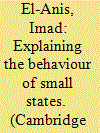| Srl | Item |
| 1 |
ID:
147963


|
|
|
|
|
| Summary/Abstract |
Conventional analyses claim that small states bandwagon with leading international powers. The dominant view is that small states' vulnerabilities and limited power hinder their ability to pursue policy goals. This study critiques this position by investigating why and how Jordan continues to pursue a nuclear energy programme despite objections from the United States—its principal ally. By using theories of small states, this study analyses discursive practices in Jordanian policymaking. This approach is used to describe Jordan's nuclear energy policy and posit a logic of the effects that energy insecurity has on the government's perception of Jordan as a ‘small state’. I use this to create hypotheses concerning the conditions under which small states may not simply bandwagon with key international allies, but may have more freedom to pursue their goals than traditional analyses predict. Explanations that assume small states always have limited freedom to pursue policy goals without the backing of key allies are not supported by the evidence considered here.
|
|
|
|
|
|
|
|
|
|
|
|
|
|
|
|
| 2 |
ID:
110350


|
|
|
|
|
| Publication |
2011.
|
| Summary/Abstract |
As the world's third leading economy and a major importer of fuels, the choice of future energy paths and policies that Japan makes in the next few years will have a significant influence on the energy security of the world as a whole, and of the Northeast Asia region in particular. In this article we describe the current status of and recent trends in the Japanese energy sector, including energy demand and supply by fuel and by sector. We then discuss the current energy policy situation in Japan, focusing on policies related to climate change targets, renewable energy development and deployment, liberalization of energy markets, and the evolution of the Japanese nuclear power sector. The final section of the article presents the structure of the Japan LEAP (long-range energy alternatives planning software system) dataset, describes several alternative energy paths for Japan - with an emphasis on alternative paths for nuclear power development and GHG emission abatement - and touches upon key current issues of energy policy facing Japan, as reflected in the modeling inputs and results.
|
|
|
|
|
|
|
|
|
|
|
|
|
|
|
|
| 3 |
ID:
177412


|
|
|
|
|
| Summary/Abstract |
Irradiated or Spent Nuclear Fuel (SNF, where it could be “used nuclear fuel” if reprocessing facilities are available) is periodically removed from nuclear power reactors and allowed to decay in suitable storage facilities. This paper attempts to calculate the relationships between sizes and costs of wet/dry and onsite/offsite SNF storage. The methodology is (1) to propose cost models based on publicly available data and (2) to estimate cost equations to compare the various storage costs. When the fuel pool nears capacity, the cheapest alternative is to transfer SNF to onsite dry storage. Once a nuclear power plant has been decommissioned, and only the onsite dry storage facility remains, there appears to be little economic reason (from the nuclear power plant owner/operator’s viewpoint) to move the SNF to consolidated facilities because of extra monetary and non-monetary costs. Unless there are explicit national policies and funded programs to manage SNF, there are likely to be legacy sites with stranded SNF. On the other hand, there is a consensus that consolidated facilities (1) would be more safe and secure than dispersed onsite storage locations, (2) would facilitate final disposal, and (3) might reduce the risks perceived by local communities of storing SNF.
|
|
|
|
|
|
|
|
|
|
|
|
|
|
|
|